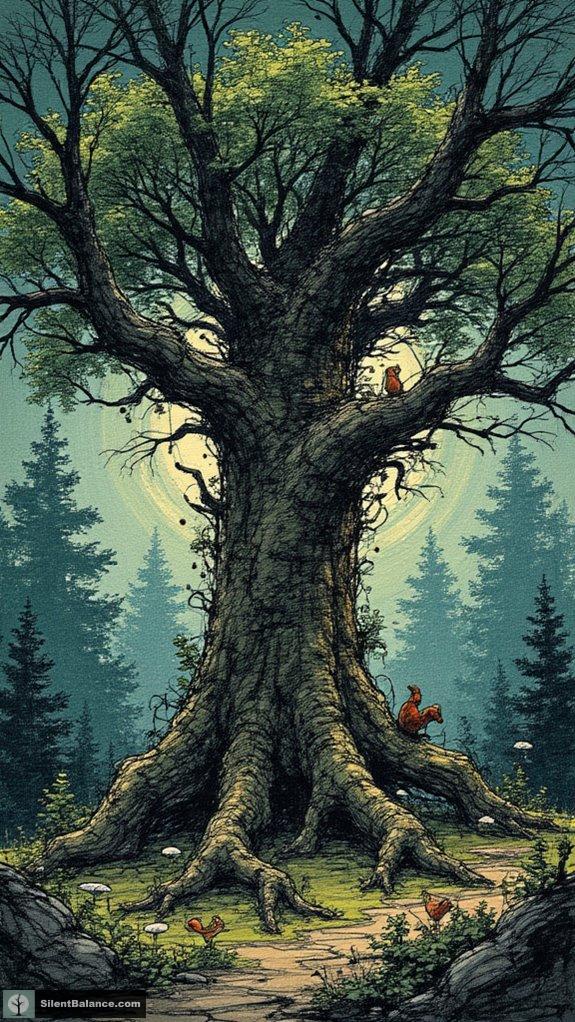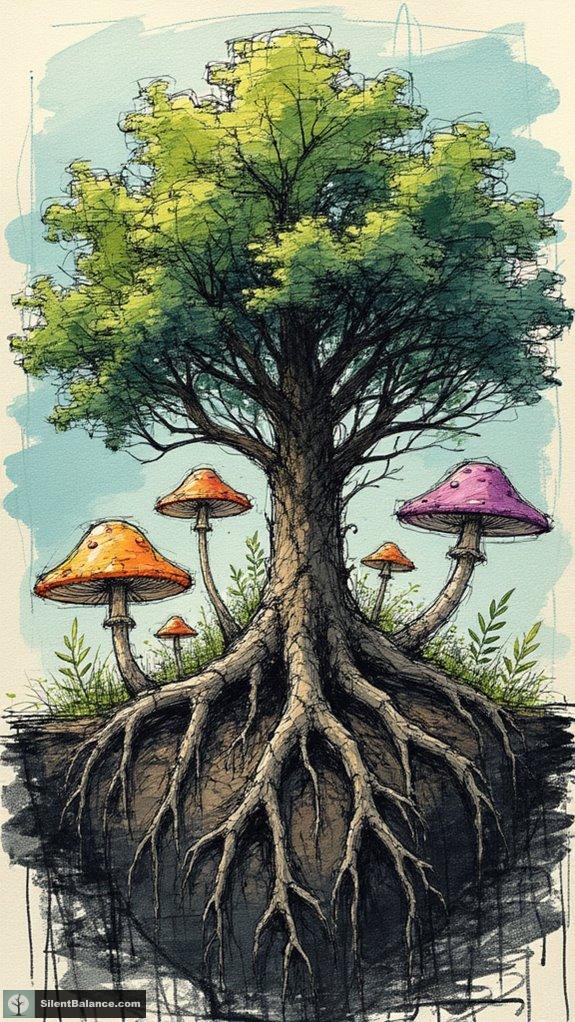Mother trees and mycorrhizal networks create a powerhouse of cooperation in our forests. Picture those ancient trees sharing nutrients with nearby saplings, all thanks to their vast underground fungal networks. These connections let trees signal distress, so a healthy oak can share carbon with a struggling fir. It’s like a forest family looking out for each other! Curious about how these natural alliances boost biodiversity and resilience? There’s so much more to uncover about these dynamic ecosystems!
Quick Takeaways
- Mother trees enhance forest biodiversity by nurturing seedlings and facilitating resource sharing through vast root systems and mycorrhizal networks.
- Mycorrhizal networks act as communication channels, allowing trees to signal distress and share crucial nutrients and water among connected species.
- Resource sharing fosters cooperation over competition, leading to increased growth rates and overall forest health, as seen with birch and fir interactions.
- Chemical signaling through volatile organic compounds (VOCs) enhances communication among trees, ensuring responses to stressors and promoting mutual aid.
- Future research aims to optimize tree interactions and resource allocation, strengthening resilience against climate pressures within forest ecosystems.
The Concept of Mother Trees in Ecosystems

Picture a towering tree, ancient and majestic, standing proud in the heart of a bustling forest. This impressive giant isn’t just a tree; it’s a mother tree, the key player in boosting ecosystem biodiversity.
When you explore mother tree identification, you recognize these giants by their vast root systems that tap into a complex web of life, connecting other trees within striking distance. Mother trees are known to exhibit kin recognition, allowing them to prioritize resource allocation to their own offspring over other trees.
These dynamos nurture seedlings through nutrient and carbon transfers, ensuring their survival during those vital early days. Not only do they enhance genetic diversity, but they also act as biodiversity islands, housing unique organisms, while also promoting resource sharing among connected trees in the forest.
The Role of Mycorrhizal Networks in Tree Communication

While you might think trees are solitary beings, they’re actually part of an underground social network, sharing secrets and resources just like a tight-knit tattoo crew.
These mycorrhizal networks are the real deal, acting as communication highways that keep trees thriving.
Consider this:
- Trees signal distress through mycorrhizal signaling, crying for help when herbivores attack.
- Nutrient exchange is the bread and butter in this relationship, as trees pass carbon and water like an artist trading ink. Mycorrhizal networks facilitate complex relationships that also enhance forest ecosystem resilience, ensuring all members can thrive despite environmental challenges.
- Connected trees flex their adaptability, altering their growth based on the signals they receive from the network.
Benefits of Resource Sharing Among Trees

You mightn’t realize it, but trees are networked like a tight band of tattoo artists, sharing resources and secrets beneath the surface.
These mycorrhizal connections are like the ultimate trade-off, enhancing resource allocation while boosting overall forest health. This phenomenon illustrates how mother trees facilitate a vibrant community through their role as keystone species in their ecosystems.
Envision this: a mother tree sending crucial nutrients to stressed saplings, making them thrive. Trees with established mycorrhizal associations can see growth rates rocket up to 70%.
It’s not just about survival; it’s a collective power play. Picture birch trees sharing carbon with firs when the light fades—now that’s inter-species teamwork!
This underground movement cultivates biodiversity, making the entire forest ecosystem resilient and robust.
The more you tap into it, the stronger your green kingdom becomes, don’t you think?
The Importance of Mother Trees in Forest Regeneration

Picture rolling up to a tattoo shop where the artist not only customizes your ink but also hooks you up with need-to-know tips about aftercare—this is basically what Mother Trees do for their forest crew.
- They boost forest resilience by nurturing younger trees through extensive mycorrhizal networks, like a tattoo artist sharing their secrets to perfect healing.
- They provide genetic stability, ensuring a solid foundation for future generations, much like a tree that’s stood the test of time.
- Acting as protectors, they shield vulnerable species from stressors, just like an artist keeps your fresh ink safe from the elements.
- These trees also facilitate chemical signaling among plants, enhancing communication and resource sharing within the ecosystem.
Embrace these majestic Mother Trees, because they’re key players in our ecological stewardship game.
Scientific Discoveries Surrounding Fungal Networks

When it comes to understanding fungal networks—those hidden, complicated webbing beneath our feet—it’s like peeling back the layers of an epic tattoo story.
These mycorrhizal networks create a badass community, connecting plants and fungi like inked siblings sharing secrets.
By facilitating nutrient dynamics, these networks optimize the transfer of carbon, nitrogen, and phosphorus, making sure everyone’s fed and thriving.
Isn’t that like running a tight-knit street crew?
Fungal diversity adds elaborate flavor to this underground ecosystem.
It’s not just about survival; it’s about smart collaboration, enhancing growth while providing a defense system against pests. Moreover, these networks demonstrate how trees can communicate with one another, revealing an intricate web of cooperation.
Future Research Directions on Tree Cooperation and Resilience

As scientists dive deeper into the magic of tree cooperation and resilience, they’re discovering that forests are more than just a collection of trees; they’re vibrant communities where trees hit the social circuit, much like inked folks bonding over their favorite art. To push the boundaries of understanding, we must focus on:
- Tree Diversity: Embrace mixed species plantations to amplify tree resilience and optimize resource allocation, creating dynamic ecosystems.
- Cooperation Mechanisms: Investigate how tree-to-tree interactions foster network stability, just like artists collaborating on a masterpiece.
- Stress Adaptation: Identify species-specific responses to drought and heat to predict how trees react under climate pressures, ensuring our forests thrive.
Moreover, exploring the roles of mycorrhizal networks may reveal intricate pathways of communication that facilitate tree cooperation. Let’s get to work—tree resilience is too essential to overlook!
Mycorrhizal Networks and Soil Communication

So, let’s get real about the underground magic of forests—literally!
Mycorrhizal networks are like the bustling highways of the soil, where mycorrhizal signaling takes the wheel. These fungal highways connect roots, sharing nutrients and essential information. Picture plants passing secret notes through these networks, alerting neighbors about stress or sabotage.
You’ve got nutrient dynamics in full play here, with fungi tapping into hidden soil treasure troves for phosphorus and nitrogen. Your plants aren’t just surviving; they’re thriving, strategically altering growth patterns based on the company they keep.
With every connected root, you’re witnessing resilience in action. It’s not just a forest; it’s a community, working in harmony—where everyone’s got each other’s back in this wild dance of survival.
Mycorrhizal Networks in Mother Tree Cooperation

Plunge into the vibrant world of Mother Trees, and you’ll soon realize they’re not just towering giants in the forest; they’re the ultimate community organizers.
Through their mycorrhizal networks, they orchestrate amazing fungal interactions and foster tree diversity by:
- Sharing crucial nutrients, like carbon and nitrogen, with younger trees that desperately need them.
- Sending distress signals across the network, igniting responses that sustain the entire forest population.
- Ensuring stronger trees access water from deep soil layers, promoting cooperation instead of cutthroat competition.
These networks create an interconnected force that boosts forest resilience, proving that cooperation in nature isn’t just nice; it’s essential for survival. Furthermore, they communicate not only through this network but also via volatile organic compounds, which play a vital role in tree interactions.
Questions and Answers
How Do Mother Trees Identify Neighboring Trees in Their Networks?
Ever wondered how mother trees spot their neighbors in the dense woods?
These botanical powerhouses use tree communication through root chemistry to identify who’s who in their network.
It’s like having a secret language underground, where roots chemically signal each other, revealing genetic kinship.
When push comes to shove, they prioritize nourishing their relatives, ensuring the survival of their crew.
Can Mycorrhizal Networks Operate Without Mother Trees?
Absolutely, mycorrhizal networks thrive on independence from mother trees.
They form robust connections through fungal hyphae, linking many plants, even amid tree competition.
Imagine those hidden fungal artists crafting an underground masterpiece, sharing nutrients and water among buddies.
Even young trees get in on the action, showing that life finds a way, right?
What Specific Nutrients Are Often Shared Through These Networks?
You might think fungi are just lurking in the shadows, but they’re essential players in nutrient exchange!
Through fungal symbiosis, these networks share important nutrients like phosphorus and nitrogen, often with ease.
Picture this: trees giving away sugary goodies for life-sustaining phosphorus, while they receive nitrogen to beef up their growth.
It’s a win-win, right?
With these underground connections, trees thrive, creating a lush, resilient forest ecosystem that’s truly a masterpiece of nature!
How Do Environmental Changes Affect Mycorrhizal Networks?
When environmental changes hit, like drought impact or temperature fluctuation, mycorrhizal networks can take a serious hit.
Soil composition shifts, reducing nutrient availability and stressing trees. Pollution effects don’t help either, as they mess with the fungal community and amplify biodiversity loss.
So, how do you keep your forest strong? By nurturing those fungal buddies!
They’re your secret weapon in maintaining healthy ecosystems. Without them, things can go south real fast!
Are There Risks Associated With Mycorrhizal Network Dependency?
You know those mycorrhizal vulnerabilities? They come with serious ecological consequences.
When you lean too hard on these networks, you risk putting all your plants in one basket. Envision a crew relying on a single artist’s style—what if they mess up? It’s the same!
Overdependence can choke out weaker plants during stress, leaving them in the dust. Keep diversity alive, or risk your green scene turning into a sketchy, monochrome nightmare.
References
- https://mothertreeproject.org/about-mother-trees/
- https://howtorewild.co.uk/magazine/what-are-mother-trees-and-master-trees/
- https://en.wikipedia.org/wiki/Mycorrhizal_network
- https://www.nationalforests.org/blog/underground-mycorrhizal-network
- https://mothertreeproject.org/glossary/
- https://emergencemagazine.org/interview/finding-the-mother-tree/
- https://www.youtube.com/watch?v=ydbzrun3opk
- https://joegardener.com/podcast/finding-the-mother-tree-how-trees-take-care-each-other-suzanne-simard/
- https://wildlife.org.au/exploring-the-secret-world-of-trees-and-their-communication-networks/
- https://pmc.ncbi.nlm.nih.gov/articles/PMC4497361/
- https://www.greatsouthbayaudubon.org/the-sandpiper/mycelium-the-forests-secret-communication-system/
- https://treenewal.com/mycorrhizal-fungi-tree-health-benefits/
- https://one-more-tree.org/blog/2025/04/04/what-do-trees-say-to-the-world-plant-communication-through-underground-mycorrhizal-networks/
- https://www.haverford.edu/arboretum/news/internet-trees-underground-social-network
- https://www.betterplaceforests.com/blog/mycelium-and-mycorrhizal-in-the-forest/
- https://www.worldwildlife.org/blogs/sustainability-works/posts/thanking-our-forest-mothers-the-role-of-mother-trees-in-restoring-the-atlantic-forest
- https://elephantinyou.com/blogs/news/mother-trees-our-green-guardians-deserving-of-protection
- https://mothertreeproject.org/about-mother-trees/faq/
- https://bsj.studentorg.berkeley.edu/mother-tree-hypothesis-the-power-of-a-mothers-love-or-wishful-personification/
- https://www.eurekalert.org/news-releases/1074573
- Bonsai Placement Benefits for Room Harmony - November 8, 2025
- Why Use Air Layering to Propagate Bonsai Trees? - November 8, 2025
- 15 Stunning Acorn Wood Wall Art Ideas - November 8, 2025

